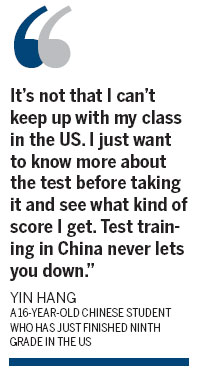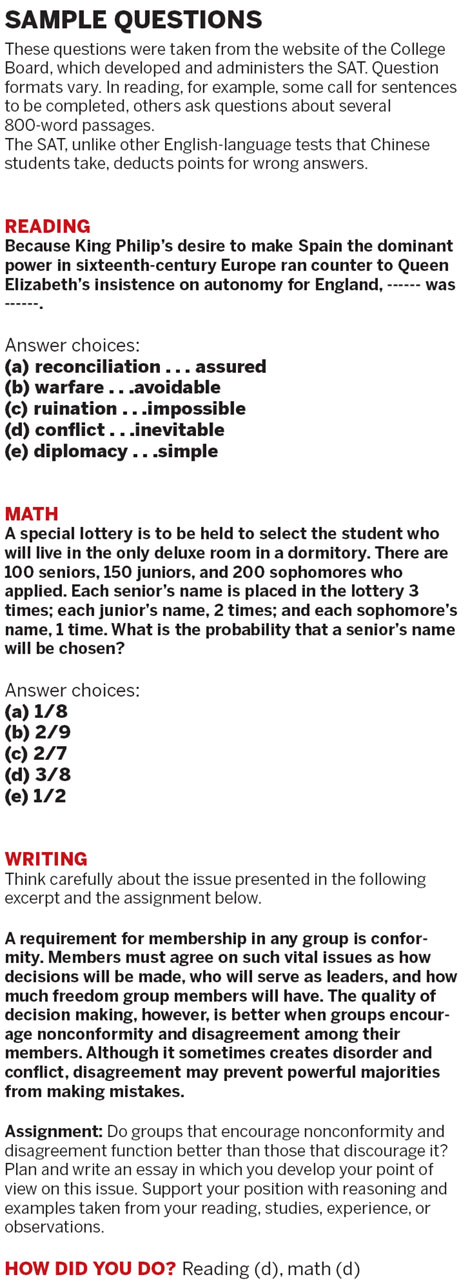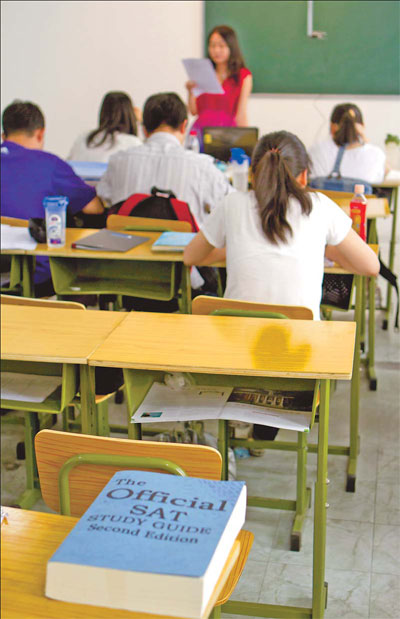Testing time for study abroad
|
Zhang Ke gives a training course for students who will take SAT at a training school in Ziming Building in Beijing. SAT is a standardized college admissions exam in the United States. Zhang Tao / China Daily |
Students broaden their horizons as they opt to take the SAT, reports Wu Wencong in Beijing.
Li Yanqi scored 653 on the latest national college entrance exam, the gaokao, which she thinks is above the entry requirement for Tsinghua University, her first choice.
Unlike her peers, though, she has scheduled no parties to celebrate. She is devoting herself this summer to another round of study - preparing for the SAT, a standardized college admissions exam in the United States.
The 2011 gaokao was Li's second attempt. Last year, she failed to get into Tsinghua with a score of 630. After another year of preparation, she sat for the exam again, but Tsinghua no longer tops her list.
"The score may not be high enough for my dream major, architecture," said the 19-year-old. "I think it is a better idea to try the top 20 universities in the US than retake the exam."
What she needs now is a high SAT score.
The SAT Reasoning Test takes three hours 45 minutes and costs $75 for international students. The top mark is 2,400, combining three 800-point sections: mathematics, critical reading and writing.
There are no SAT test centers on the Chinese mainland, so candidates must go to Hong Kong or Singapore to take the test, which is scheduled six times a year for students from the mainland.
About 200 mainland students took the SAT in Hong Kong in 2003. The figure rushed to 7,000 in 2008 and to more than 20,000 last year, said Tony Chan, manager of the international and professional examinations division of the Hong Kong Examinations and Assessment Authority, in an earlier interview with China Daily.
In contrast, the number of students taking China's national college entrance exam has dropped for three consecutive years, from 10.5 million in 2008 to 9.3 million this year, according to the Ministry of Education.
Target: Overseas
At least some of the "missing" students have turned their targets abroad. A study last year by Education First, an international education company that specializes in language training, found that 41 percent of about 3,000 parents interviewed plan to send their kids abroad right after high school.
The first choice of most parents is the United States.
About 40,000 undergraduate students from the Chinese mainland were studying in the US last year, 52 percent more than in 2009, says the Open Doors Report 2010 released by the Institute of International Education. And the 2009 figure was 60 percent higher than the total the year before.
To deal with the student boom, some top 50 universities in the US raised their entry requirement for Chinese students' SAT results from 1,800 to 1,900. And the market for SAT-preparation courses is booming.
Students prepare for the SAT primarily in one of three forums: at international schools, where all the graduates attend college outside the mainland; in international classes at public high schools, where small groups of students aim at universities abroad; and through private professional training agencies.
Hou Shijun, who founded Beijing Ziming Education and said he was the first to enter the market of professional SAT training on the Chinese mainland, said students surged from only seven in 2004 to more than 2,000 in Beijing alone last year.
He said the number has risen by 20 to 30 percent every year, and there are about 25,000 to 30,000 SAT-prep students across the country, "most in their first year or second year in high school."
Starting early

It's not only high school students in China who go in for SAT training. Many Chinese students who attend high schools abroad are also keen on the course.
Yin Hang, 16, has just finished ninth grade - her first year in a private school in McLean, Virginia - and returned to China for summer holiday. Like many of her friends, she asked her mom to reserve a seat in an SAT-prep class.
"High schools in the US won't emphasize training dedicated to SAT test until 11th grade. Before that, all the related courses are simply about proficiency in the language rather than targeting any tests," she said.
"It's not that I can't keep up with my class in the US. I just want to know more about the test before taking it and see what kind of score I get. Test training in China never lets you down."
Critical thinking
Hou said it's important that parents and students understand the SAT is designed to assess critical thinking, not English proficiency, so excellent English alone is of no use. Kang Xinghua, 28, who has taught SAT classes for five years, agrees.
He said the vocabulary needed for the SAT is 12,000 to 15,000 words, more than the requirement for a Chinese university graduate who majored in English. But it's not the English that hinders students taking the SAT; it's the learning methods and study habits picked up over the years, "the lack of a Western way of thinking and the ability to make logical deductions."
Kang said he is researching a book he will write about SAT training, and he just returned from the US, where he talked to 20 professors at top 50 universities. "Almost all of them told me that the problem lies in vocabulary only when a student scores between 500 and 600 in reading."
He said the mean scores of college-bound US seniors have not exceeded 510 in the past 34 years, according to data released by the College Board, which developed and administers the exam.
Too few teachers
Of all the forms of SAT training classes, Hou said market share is dominated by training schools such as his Ziming Education and Beijing-based New Oriental Education and Technology Group.
Some public high schools work with professional training centers, he said, but the centers themselves don't have enough teachers to handle the boom in students.
For example, Jinling High School in Nanjing, capital of Jiangsu province, has offered an international class for four years, but it could end this year. "We are running out of teachers to support the class," said a consultant named Chen at USA Daxue, which provides SAT teachers to Jinling High School.
Still, students keep applying for such classes and are accepted by top 20 American universities, some with scholarships.
More than 70 students, 20 percent of the graduates, from the high school affiliated with Fudan University in Shanghai have been accepted by foreign universities, about seven times as many as five years ago. About 60 students in the high school affiliated with Renmin University in Beijing will start higher education abroad this year, 50 percent more than last year.
"Public high schools have their own advantages in running international classes," said Wang Yongmei, who is in charge of enrollment in the class at Beijing Changping No 1 High School. The classes last longer, she said, and target more than the SAT test.
Grade point average is important, she said, along with "social practices like charity work, and other training that is valued by foreign universities, so that students can be qualified for top universities in the US not only in terms of test scores."
It's expensive
This kind of training doesn't come cheaply.
Muazzem Hussain, 30, is a British teacher in the international school at a public high school in Changshu, Jiangsu province. He said all 24 of his students come from rich families that own private businesses. The cost of the full curriculum each year is 200,000 yuan (about $30,940), he said.
Like many schools, Hou's training school (the one high school student Yin attends) offers SAT classes of various lengths, from one week to one year. A weeklong intensive training session costs about 4,000 yuan (about $620), and a yearlong class costs almost 20,000 yuan (about $3,200).
In addition, Hou said, the cost of pursuing a bachelor's degree in the US far exceeds that of a master's. "More than 1 million yuan is the basic."
But Chinese parents see a payoff ahead.
Wang Zhijuan, Yin's mother, expects her daughter will have better job opportunities after she finishes university in the US. But she cares more about the independence Yin gained in just her first year of study abroad.
"She came back confident, with good manners, expressing herself gracefully in front of strangers, unlike other kids her age, who would normally shy behind their parents," she said. "I think the money, about $50,000 a year, is worth it."
Secondary profit
Not only education institutions have determined to seize the SAT training market. Travel agencies have seen opportunity there, too.
Gong Changwu, manager of BTG International Travel and Tours, said the company has begun cooperating with education agencies to send groups of students to Hong Kong since 2005.
"At that time, there were only about 80 students taking part in the SAT test in Hong Kong through our company," he said. "Now the number is over 600. And we are simply a very small share in the market."
The service costs 4,000 to 6,000 yuan, depending on accommodations. The trip usually lasts four days and three nights, leaving a full day before the test day.
Gong said do-it-yourself travel planning has cut into agency business, but SAT travelers are different. Parents call for complete relief of making travel arrangements and are willing to pay for it.






















